No products in the cart.
Return To Shop
Understanding the Clergy & Their Sacred Attire
In every faith tradition, the clergy hold a special and sacred place. They serve as leaders, teachers, counselors and representatives of spiritual truth. In Christianity, whether you see them in a grand cathedral, a small village church, or at a community outreach event, clergy are instantly recognizable not only by their words and actions but also by their distinctive attire. Their clothing, known collectively as Clergy Wear, is more than just fabric; it is a visible symbol of dedication, humility, and service to God.
In this guide, we’ll take an in-depth look at who the clergy are, what they wear, the meaning behind each garment, and how these traditions have adapted over time. Whether you are a clergy member, a seminary student, or someone curious about faith traditions, this article will give you a detailed understanding of both the people and the attire that mark them as spiritual leaders.
1. Who Are the Clergy?
The word clergy refers to ordained ministers, priests, pastors, deacons, and other religious leaders set apart for sacred duties. In Christianity, this can include bishops, priests, pastors, ministers, and elders, depending on the denomination.
Historical Background
The concept of a distinct group of religious leaders goes back thousands of years. In the Old Testament, priests served in the Temple, offering sacrifices and teaching the Law. In the New Testament, early church leaders such as apostles, elders, and deacons were recognized as spiritual guides. Over centuries, the structure of the church formalized, and the role of clergy became more defined, often accompanied by distinctive dress.
Responsibilities of the Clergy
Clergy are entrusted with responsibilities that go beyond leading Sunday services. They:
- Preach and teach Scripture.
- Lead worship and administer sacraments.
- Offer pastoral counseling and spiritual guidance.
- Perform baptisms, weddings, and funerals.
- Represent the church in the community.
The Spiritual Authority of the Clergy
Clergy wear a visible sign of their role so that they are recognized as spiritual leaders wherever they go. This tradition is rooted in the belief that their position is not just a job, but a calling one that is sacred and lifelong.
2. The Significance of Clergy Wear
Clergy wear is not merely about tradition or aesthetics; it carries deep meaning. Every collar, robe, or stole worn by a minister is a reminder of their mission and the sacred nature of their work.
Symbolism
- Separation from the World: Clergy wear marks the wearer as someone set apart for ministry.
- Humility and Service: The modest designs and colors often reflect humility before God.
- Unity in Worship: Standardized attire helps shift attention from the individual to the message being shared.
Practical Functions
While symbolic, clergy wear is also functional. Robes and cassocks are comfortable for long services, and collars make clergy instantly identifiable in hospitals, prisons, and public spaces.
3. Types of Clergy Wear
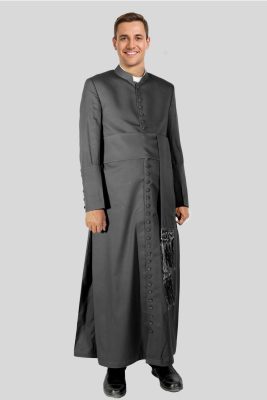
Clergy wear varies between denominations, regions, and occasions. Here are the most common types:
Cassocks
An ankle-length garment worn by many Christian clergy, especially in Anglican, Catholic, and Orthodox traditions. Traditionally black, but also found in white, purple, and red.
Key Features:
- Buttoned from neck to hem.
- Often worn under liturgical vestments.
- Symbolizes humility and dedication.
Clergy Robes
More common in Protestant traditions, Clergy Robes are flowing garments worn over regular clothes during worship.
Styles:
- Geneva robe (simple and academic in style).
- Liturgical robe (often more ornate, sometimes with embroidery).
Clergy Shirts and Collars
The clerical collar white, crisp, and distinctive is one of the most recognizable symbols of Christian ministry. Traditionally paired with clergy shirts in classic shades like black and gray, as well as other dignified colors, it is worn as a visible sign of devotion and service in daily ministry.
- Full Collar: A continuous white band that fully encircles the neck, offering a traditional and formal look.
- Tab Collar: Features a small white insert at the front, providing a clean, modern appearance while retaining clerical identity.
- Neckband Collar: Designed to be worn with a detachable white collar, allowing for versatility and easy maintenance.
These collars not only complete the professional look of clergy attire but also carry deep symbolic meaning representing humility, dedication, and the sacred calling of ministry.
Stoles and Chimeres
- Stole: A long, scarf-like vestment draped around the neck, symbolizing the authority and responsibilities of ordained ministry. The color of the stole changes with the liturgical season or specific church celebrations, serving as both a decorative and symbolic element.
- Chimere: A dignified, sleeveless robe traditionally worn by bishops over a white rochet. Often made from rich fabrics in colors such as red or black, the chimere conveys episcopal authority and a sense of solemnity during formal services.
Liturgical Vestments
In more formal or traditional worship settings, clergy may wear additional vestments such as:
- Alb: A long, white robe symbolizing purity and the baptismal garment.
- Surplice: A white, flowing garment with wide sleeves, typically worn over a cassock.
- Cope: A ceremonial cloak, often richly decorated, used for processions or other special liturgical occasions.
These garments are more than attire they are rich in tradition, conveying reverence, authority, and the sacred role of the clergy in worship.
4. Colors and Their Meanings in Clergy Wear
Clergy wear color is not random; it follows the liturgical calendar.
- Black: Humility, mourning, and devotion.
- White: Purity, holiness, and joy (used at weddings, baptisms, Easter).
- Purple: Penitence and preparation (Advent and Lent).
- Red: The Holy Spirit, Pentecost, and martyrs.
- Green: Ordinary time growth and spiritual renewal.
5. Modern Trends in Clergy Wear
While the roots of clergy wear are ancient, the modern church has embraced new styles and fabrics.
- Lightweight, breathable fabrics for comfort in warmer climates.
- Gender-inclusive designs for women in ministry.
- Custom tailoring for better fit and professional appearance.
- Ethically sourced materials reflecting stewardship values.
6. Choosing the Right Clergy Wear
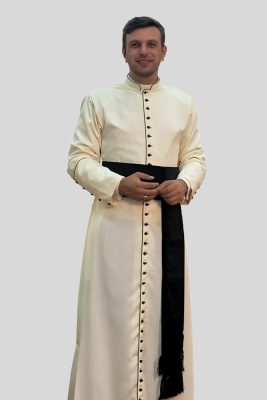
Selecting clergy wear is a blend of tradition, personal preference, and practicality.
Considerations:
- Denomination guidelines.
- The climate of your region.
- Frequency of use.
- Quality and durability.
Tip: A high-quality cassock or robe can last for years if properly cared for.
7. Caring for Clergy Wear
- Cleaning: Many clergy garments are dry-clean only; always check care labels.
- Storage: Store in a cool, dry place; use garment bags for robes.
- Maintenance: Repair loose buttons or seams promptly to maintain a professional look.
8. Where to Buy Premium Clergy Wear
Today, clergy can purchase attire from both local religious supply stores and global online retailers.
Why Buy from Holy Clergy?
- Wide range of robes, cassocks, shirts, and accessories.
- Premium fabrics and expert tailoring.
- Worldwide shipping with both standard and express options.
- Custom sizing for the perfect fit.
Conclusion
The role of the clergy is deeply significant, and the attire they wear reflects centuries of tradition, respect, and devotion. From the humble cassock to the elegant stole, each piece tells a story of service and sacred duty. As the church evolves, clergy wear continues to blend the timeless with the modern, ensuring ministers can serve with both dignity and comfort.
If you are a member of the clergy or preparing for ordination, choosing the right clergy wear is an important step in embracing your calling. Invest in garments that honor both your tradition and your personal comfort.
At Holy Clergy, we honor your ministry with garments that combine tradition, quality, and style. Explore our premium collection of robes, cassocks, shirts, and accessories today and serve in attire worthy of your calling.
Frequently Asked Questions (FAQ’s)
What is clergy wear?
Clergy wear refers to the distinctive garments worn by ordained ministers, priests, pastors, and other religious leaders during worship services, ceremonies, and daily ministry. These garments such as cassocks, robes, stoles, and clergy shirts serve both symbolic and practical purposes. They identify the wearer as a spiritual leader, reflect religious tradition, and help maintain a respectful and unified appearance in worship.
Why do clergy wear special garments?
Clergy wear special garments to symbolize their calling, represent the sacred nature of their role, and differentiate their position from the congregation. These garments often carry deep spiritual meaning, reminding both the clergy and the community of the responsibility, humility, and service expected of a minister. In addition, clergy wear helps maintain liturgical tradition and creates a sense of reverence during religious ceremonies.
What is the difference between a cassock and a robe?
A cassock is a long, close-fitting, ankle-length garment, usually buttoned from the neck to the hem. It is traditionally worn by clergy in Catholic, Anglican, and Orthodox traditions, often as an undergarment beneath vestments.
A robe, on the other hand, is a looser, flowing garment typically worn over regular clothing during worship services. Robes are more common in Protestant traditions and may vary in style, such as the Geneva robe or liturgical robe.
What does the clerical collar symbolize?
The clerical collar a white band worn around the neck symbolizes a minister’s commitment to God and the church. It represents humility, spiritual authority, and readiness to serve. The collar also makes clergy easily identifiable in public spaces, hospitals, and community events, reinforcing their role as accessible spiritual leaders.
Why do clergy wear black?
Traditionally, clergy wear black to symbolize humility, simplicity, and a life set apart for God’s service. Black also represents the seriousness of their calling and serves as a visual reminder of mortality, encouraging focus on eternal life rather than worldly distractions. While black remains the most common color, other liturgical colors are worn for specific church seasons and celebrations.
What do different colors in clergy garments mean?
Clergy garment colors follow the liturgical calendar, each carrying specific symbolic meaning:
- Black: Humility, mourning, and devotion.
- White: Purity, joy, and celebration (weddings, baptisms, Easter).
- Purple: Penitence and preparation (Advent, Lent).
- Red: The Holy Spirit, Pentecost, and martyrdom.
- Green: Growth and renewal during Ordinary Time.
What are the main types of clergy robes?
The most common types of clergy robes include:
- Geneva Robe: A simple, academic-style robe often worn in Protestant traditions.
- Liturgical Robe: Often more ornate, used for formal church services.
- Alb: A long white garment symbolizing purity, worn under or over other vestments.
- Surplice: A loose, white garment with wide sleeves, worn over a cassock.
- Chimere: A sleeveless robe often worn by bishops over a white rochet.
What fabrics are best for clergy wear?
The best fabrics for clergy wear combine comfort, durability and elegance. Popular choices include:
- Polyester blends: Wrinkle-resistant and easy to maintain.
- Wool blends: Warm, durable, and ideal for cooler climates.
- Cotton blends: Breathable and comfortable for everyday wear.
- Lightweight microfiber: Perfect for warmer regions and long services.
How should clergy wear be cared for and stored?
Proper care helps preserve the quality and appearance of clergy garments:
- Cleaning: Follow the garment’s care label; many items are dry-clean only.
- Storage: Hang robes and cassocks on padded hangers in a cool, dry place; use garment bags to protect from dust.
- Maintenance: Repair any loose buttons, hems, or seams promptly.
- Special Care for Collars: Wipe clerical collars after each use and store flat to maintain shape.



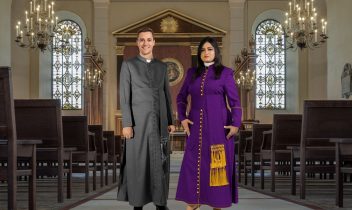
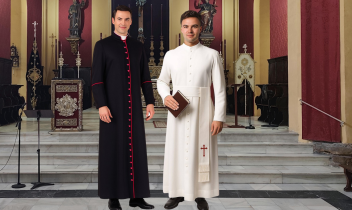
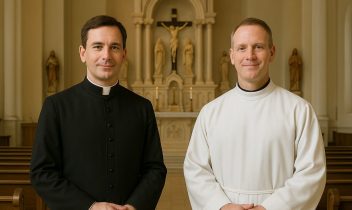
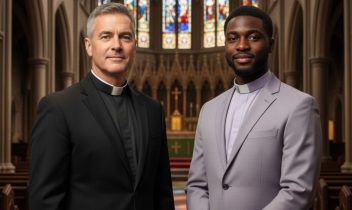
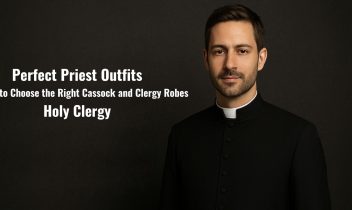
Recent Comments